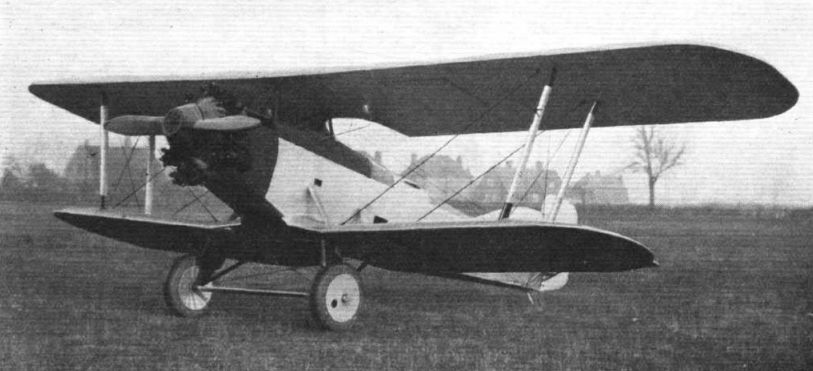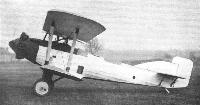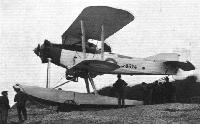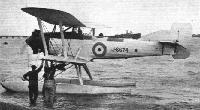
Описание
Страна : Великобритания
Год : 1927
Единственный экземпляр
Прототип двухместного дневного бомбардировщика/торпедоносца
Gloster Goring
Под обозначением Gloster Goring компания разработала и построила в инициативном порядке прототип двухместного бомбардировщика/торпедоносца в рамках требований, предъявляемых по спецификации 23/25. Самолет представлял собой одностоечный неравнокрылый биплан, преимущественно деревянной конструкции, с неубирающимся шасси с хвостовым костылем и первоначально оснащенный звездообразным двигателем Bristol Jupiter VI. Прототип самолета (J8674) совершил первый полет в марте 1927 года, он оснащался уже двигателем Bristol Jupiter VIII мощностью 460 л.с. (343 кВт), но конкуренции с представленными на тендер самолетами компаний "Handley Page", "Hawker" и "Westland" он не выдержал. Однако позже самолет с этой же силовой установкой был оборудован двухпоплавковым шасси и прошел новый цикл испытаний, после чего был приобретен Министерством авиации в сухопутном варианте, но с двигателем Bristol Jupiter XF мощностью 575 л.с. (429 кВт). Впоследствии самолет использовался в Филтоне в качестве летающей лаборатории для отработки двигателей и оснащался в разное время двигателями Mercury VIIA мощностью 745 л.с. (556 кВт), Pegasus Н мощностью 570 л.с. (425 кВт) и Perseus IIL мощностью 670 л.с. (500 кВт).
ТАКТИКО-ТЕХНИЧЕСКИЕ ХАРАКТЕРИСТИКИ
Gloster Goring (прототип самолета сухопутного базирования)
Тип: прототип двухместного дневного бомбардировщика/торпедоносца
Силовая установка: один 9-цилиндровый звездообразный ПД Bristol Jupiter VI мощностью 425 л. с. (317 кВт)
Летные характеристики: макс. скорость на высоте 1220 м - 219 км/ч; практический потолок 5030 м; продолжительность полета на высоте 4570 м - 6 ч 30 мин
Масса: пустого 1322 кг; максимальная взлетная 2358 кг
Размеры: размах крыла 12,80 м; длина 9,14 м; высота 3,51 м; площадь крыльев 41,81 м'
Вооружение: один фиксированный стреляющий вперед 7,7-мм пулемет Vickers и один 7,7-мм пулемет Lewis на шкворневой установке в задней кабине, плюс - на серийном варианте - до четырех 51-кг бомб под крылом, а в варианте торпедоносца-бомбардировщика - одна торпеда под фюзеляжем (это требовало модификации основных опор шасси)
Описание:
- Gloster Goring
- Flight, May 1928
THE GLOSTER "GORING" - Flight, July 1928
THE GLOSTER "GORING I”
Фотографии
-
Flight 1928-05 / Flight
Регистрационный номер: J8674 [10] THE GLOSTER "GORING"AS A LANDPLANE: The single-bay bracing, down-curving wing roots, streamlined "nose" and general "cleanness" bear testimony to Gloster racing experience applied to service types. The engine is a Bristol "Jupiter."
-
Air Pictorial 1955-08 / Air Pictorial's photo-review
Регистрационный номер: J8674 [10] GLOSTER GORING. The Goring was a private venture to replace the Hawker Horsley, then (1927) in service as a light bomber with the R.A.F. The Air Ministry intimated, however, that the engine they would like to see installed was the Bristol Orion fitted with an exhaust-driven supercharger. Accordingly, one Goring airframe was so equipped, but due to the failure of the Orion and its supercharger, this particular variant was not proceeded with. Another Goring, powered with a Bristol Jupiter 8-geared engine, met with very much more success.
As a bomber, the Goring carried 700 lb. of bombs; in addition, the observer had a Vickers machine-gun carried on a rotating mount in the rear cockpit, and provision for a second gun firing through the bottom of the fuselage. In this condition the Goring had a duration of 6 1/2 hours at 15,000 ft. At a later stage the Goring was converted into a twin-float seaplane, still powered by a Jupiter 8. This decreased the maximum speed by only 4 m.p.h. and made similarly small alterations to performance figures of the land plane. The floats were of Gloster design and were made entirely of anodised duralumin . Unfortunately. the Goring was never accepted as a production aeroplane, and although this second aircraft was taken over by the Ministry for research work in connection with engines, the type was not ordered into production. Span 42 ft.; gross weight 5.400 lb.; max. speed 123 m.p.h. -
Flight 1928-07 / Flight
Регистрационный номер: J8674 [10] -
Flight 1928-05 / Flight
Регистрационный номер: J8674 [10] The Gloster "Goring" as a Seaplane: Side view of the machine on the beach. Note the bombs suspended under the bottom plane.
-
Flight 1928-05 / Flight
Регистрационный номер: J8674 [10] Gloster G.25 Goring проектировался под спецификацию от 1925 года на торпедоносец-бомбардировщик, в серию не пошел, но активно использовался как летающая лаборатория.
The Gloster "Goring" about to go out for a flight over Southampton Water. -
Aeroplane Monthly 1982-11 / P.Capon - Capon's Corner
Регистрационный номер: J8674 [10] Seen on Hamble's slipway in May 1928 is the Gloster Goring seaplane, J8674, a two-seat day bomber/torpedo biplane powered by one 425 h.p. Bristol Jupiter VI engine.
-
Flight 1928-05 / Flight
Регистрационный номер: J8674 [10] OFF FOR FULL-LOAD TRIALS: The Gloster "Goring" taxying out for a start. In this and the other photographs the machine is shown with Bristol "Jupiter VI." Actually it was designed for, and can be obtained fitted with the "Jupiter VIII" geared engine, when an even better performance, particularly in the matter of take-off and climb, is obtained.
-
Flight 1928-05 / Flight
Регистрационный номер: J8674 [10] REPRESENTATIVE TYPES OF BRITISH AIRCRAFT: 1. The Gloster "Goring-Jupiter" two-seater seaplane.
-
Flight 1928-05 / Flight
Регистрационный номер: J8674 [10] THE GLOSTER "GORING" SEAPLANE IN FLIGHT: These photographs were obtained during full-load trials over Southampton Water. The pilot was Mr. Rex Stocken.
-
Air Pictorial 1955-08 / Air Pictorial's photo-review
GLOSTER GORING.
- Фотографии










